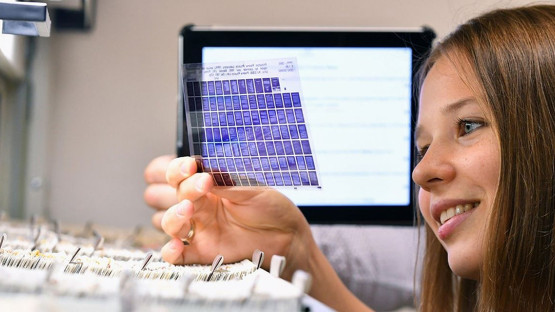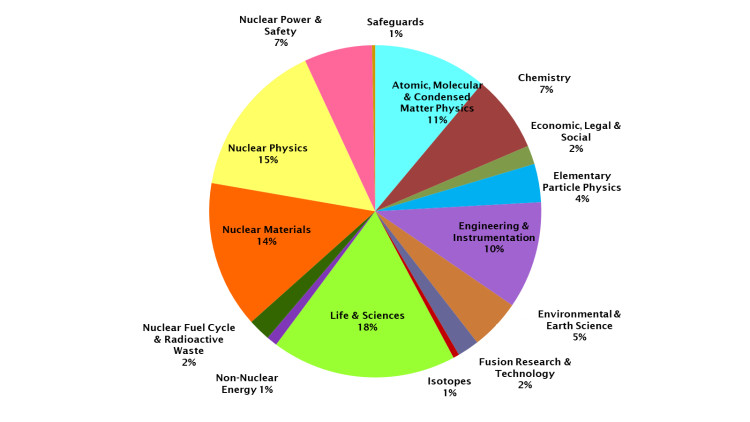This year, the IAEA’s International Nuclear Information System (INIS) celebrates its 50th anniversary. Created as a computerized bibliographic database for IAEA Member States to share and preserve their information, INIS today hosts one of the world's largest and most comprehensive collections of published information on the peaceful uses of nuclear science and technology.
Approved by the IAEA Board of Governors in 1969 to further the IAEA’s mandate to “foster the exchange of scientific and technical information on peaceful uses of atomic energy,” INIS started producing its first electronic and printed output products in 1970 and was, at the time, truly a trailblazer in the world of scientific and technology information exchange.
At the start, INIS comprised 25 IAEA Member States who contributed their published national scientific non-conventional (NCL) and conventional literature to the INIS repository. Never before had such a geographically and linguistically diverse group of nations cooperated to offer free, easy to find, and trusted information from a central repository to scientists, researchers, information specialists, students and others.
Initially, the inputting process was tedious and required a lot of manpower. Member States would mail paper documents to the IAEA, where they would be photographed and converted to microfiche. Afterwards INIS staff would check the incoming information, combine it into a single computer-readable file and distribute it to Member States as machine-readable tapes and semi-monthly abstracting journals. Starting with an annual input in 1970 of 3950 records, INIS input is currently around 100,000 records per year.
“People of the late 1960s were dealing with a quite different world. It was a paper-based society, where ‘snail’ mail, cables and telefaxing were the norm and communication was costly and slow,” said Deborah Cutler, Alternate INIS Liaison Officer for the U.S. “The need to share key information worldwide and expand knowledge was not just important for society, it was essential for the scientific community.”
INIS has always been unique in that it offers full-texts of documents not available through commercial channels, such as theses and dissertations, conference proceedings, abstracts, and scientific and technical reports.
The INIS Repository Search interface requires constant maintenance to remain relevant and in line with modern IT trends. Advances in information technology call for efficient digital transformation, but also offer great opportunities for keeping INIS as one of the leading nuclear information repositories.
“INIS continues to be innovative by vigorously introducing new IT trends. Harvesting records was implemented several years ago and applying machine learning techniques will allow us to move towards automated subject analysis and categorization,” said Dobrica Savic, Head of the Nuclear Information Section. “Meeting the needs of users coming from the Member States is of particular importance to us. We offer a top-of-the-line multilingual search interface connected to a unique INIS thesaurus that is available in 8 languages. This allows users to search across multiple languages, irrelevant of the initial interface-language chosen.”
As a preservation tool, INIS plays an important role in assisting Member States to retrieve lost information and create their own digital repositories.
Thanks to digital copies saved at INIS, the Yerevan Physics Institute (YerPhi) in Armenia was able to recover more than 1000 research papers on high-energy physics and astrophysics which had become damaged and unreadable due to improper storage conditions.
“In the 60s, 70s and 80s we distributed our research papers among all large laboratories and transferred them to the IAEA,” said Ashot Chilingarian, Director of YerPhI. “Fortunately, INIS had digitized and preserved all the archives, which are now accessible to us in digital form. They have been literally saved.” The INIS team assisted YerPhi in setting up a digital scientific repository and made all of the recovered research papers available via a dedicated web site.
A similar project saved thousands of documents from the archives of the Vinča Institute of Nuclear Sciences in Serbia.
“The INIS Repository is an incredible resource to which Canada is very proud to have participated in the creation, maintenance, and support,” said Jeanine Tilson, INIS Liaison Officer for Canada. “INIS facilitates the ability to collaborate, share resources, and exchange information with other INIS centres around the world which serves to enrich and advance nuclear research to the benefit of everyone.”





